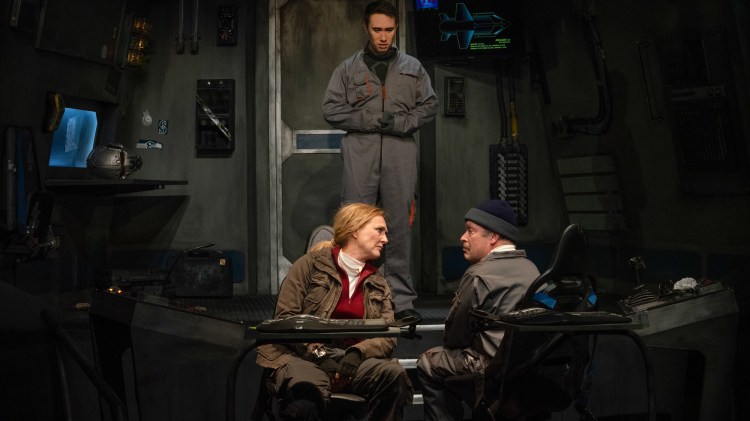Last Ship to Proxima Centauri is set somewhere uncommon for the theater: the deck of a nearly thousand-year old spaceship.
Playwright Greg Lam, set designer Germán Cárdenas-Alaminos and ensemble member Tom Ford joined a conversation to preview the story—no spoilers, please!—and describe how they bring a galaxy that’s more than four light years away right onto Forest Ave. This interview has been edited and condensed for clarity.
Molly Adams: I love science fiction as a genre and I now realize I have rarely, if ever, seen a sci-fi play. Am I just out of the loop?
Greg Lam: There are playwrights doing sci-fi and there are theaters that specialize in it, but it is sort of rare despite the long tradition of using sci-fi to talk about the issues of the day. I was imagining the British colonizing the Americas, but setting it in space, colonizing a new planet, and giving Americans the social status of refugees. The last ship to arrive is hundreds of years late. So what they thought would be their old home just somewhere else is a different society with a welcoming crew that is not as welcoming as they’d hoped.
Do you think you created a challenge for set designers? Was designing a spaceship something new for you, Germán?
Greg: In the script, there are specifics but it is written for set designers to interpret for their own theater. And the conventions of theater are here. It’s one set that changes appearance in between the two acts, but instead of a living room, it’s a spaceship bridge.
Germán Cárdenas-Alaminos: I was absolutely excited to do this. What are the things that will immerse the audience in “space”? It was a great challenge because I was looking at images of famous spaceships in our culture, which are mostly from movies. So, the first trick to figure out as a designer was to make sure that the cockpit seemed to be floating on the stage but then we want to accomplish some sort of disarray. It’s lived in. It’s right here. I want people to think, “Oh wow! How long have they been going through space?”
Now for Act 2, without spoilers, I love to collaborate with lighting designers. The colors of the spaceship, the colors of costumes, building an environment outside the ship—the nature of light abstracts and it allows the audience to build an image on their own.
Tom, you have played a range of characters in your career, including an antihero like Scrooge in A Christmas Carol or a villain like Miss Trunchbull in Matilda. What is it like to tap into a Captain America-type, a role that used to be heroic and is now farcical?
Tom Ford: I get a little upset to my stomach before rehearsal in a way I haven’t before. Captain Morris has a lot of thoughts, behaviors and attitudes that are problematic to me and I have to tap into a straight, white, male privilege that is hard to embrace as my own. Yet, I’ve worked with Portland Stage off and on for twenty years. I go in there unconsciously owning it. Working on this play, I am now more conscious of a new person in the space, a person of color in the space, someone who hasn’t worked there before. Am I making space for them to have ownership like I do? To do that without getting self-judgy is hard.
Are you the bad guy?
Tom: Well, there isn’t any real villain or hero in the play. Everyone is problematic in their own way. Audiences might find me to be the most problematic! But because of how Greg wrote it, if I am not committed to the fullest, it’s not funny.Greg has written literal punch lines, because you are laughing at something you probably shouldn’t be laughing at. I can’t imagine anyone seeing this show and not talking at length afterward.
So it’s funny too!
Germán: Some lines are like a coin flipping, totally changes your perspective.
Greg: This play is incredibly challenging for actors. Dark-comedy would be a good descriptor. It taps into the zeitgeist in ways I could not have anticipated, from race relations to the role that China plays in this production. Since I started writing this years ago, a lot of things have gained resonance that are good for the play… but bad for the world.
This interview has been edited and condensed for clarity.

Comments are not available on this story.
Send questions/comments to the editors.


